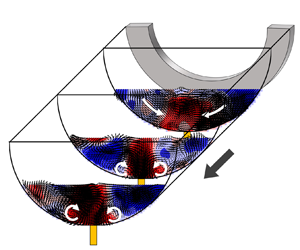Article contents
Large-scale energetic coherent structures and their effects on wall mass transfer rate behind orifice in round pipe
Published online by Cambridge University Press: 21 September 2021
Abstract

This paper first uses a low-speed stereoscopic particle image velocimetry (SPIV) system to measure the convergent statistical quantities of the flow field and then simultaneously measure the time-resolved flow field and the wall mass transfer rate by a high-speed SPIV system and an electrochemical system, respectively. We measure the flow field and wall mass transfer rate under upstream pipe Reynolds numbers between 25 000 and 55 000 at three specific locations behind the orifice plate. Moreover, we apply proper orthogonal decomposition (POD), stochastic estimation and spectral analysis to study the properties of the flow field and the wall mass transfer rate. More importantly, we investigate the large-scale coherent structures’ effects on the wall mass transfer rate. The collapse of the wall mass transfer rates’ spectra by the corresponding time scales at the three specific positions of orifice flow suggest that the physics of low-frequency wall mass transfer rates are probably the same, although the flow fields away from the wall are quite different. Furthermore, the spectra of the velocity reconstructed by the most energetic eigenmodes agree well with the wall mass transfer rate in the low-frequency region, suggesting that the first several energetic eigenmodes capture the flow dynamics relevant to the low-frequency variation of the wall mass transfer. Stochastic estimation results of the velocity field associated with large wall mass transfer rate at all three specific locations further reveal that the most energetic coherent structures are correlated with the wall mass transfer rate.
Information
- Type
- JFM Papers
- Information
- Copyright
- © The Author(s), 2021. Published by Cambridge University Press
References
- 3
- Cited by


